Kia Sorento Vs Kia Telluride Comparison: Which Crossover is Right For You?

Kia is one of just a handful of automakers with two three-row crossovers available. But which one suits your needs best?
The smaller of this dynamic duo is the Kia Sorento. Recently reimagined for the 2021 model year, the Sorento is Kia’s Goldilocks-style approach to the soft-roader market: a pair of part-time third-row seats out back when you need them, but in a more manageable package for when you don’t.
Get a Quote on a New Kia Sorento or TellurideThe only thing bigger than the Telluride has been the market’s response to it. Kia hit a home run on the first pitch here, and well over a year after the Telluride launched, it’s still spending short times on dealer lots, and trading hands above MSRP.
We’re here to figure out the better fit for your family needs. Let’s get on with it, shall we?
Cabin Space
Sorento: Following its latest growth spurt, the Sorento rides on a 110.8-inch (2,815 mm) wheelbase, with seating for up to seven. In a rare twist, the second-row legroom is the best in the house at 41.7 inches (1,060 mm), just shading the 41.4 (1,052 mm) up front. Head room measures 40.3 inches (1,024 mm) for the front row and 39.1 inches (994 mm) in the middle of the Sorento. At 74.8 inches (1,900 mm) wide, the Sorento has ample hip and shoulder room in the first two rows.
SEE ALSO: Mazda CX-9 vs Toyota Highlander ComparisonNaturally, the third row offers much tighter accommodations. Headroom is 36.8 inches (935 mm)—just an inch shy of the Telluride—but legroom is 29.6 inches (752 mm). That’s more than the larger Toyota Highlander. Hip and shoulder room are both down too, but you’re only squeezing two people back there.
Telluride: Coming in at just shy of 8 inches (200 mm) longer, the Telluride offers more space for every seat. Well, almost: there’s less headroom in the first and second rows, to the tune of 0.8 inches (20 mm) and 0.4 inches (9 mm), respectively. Way-back riders get an extra inch over Telluride’s though, with 37.8 inches (961 mm) of noggin-rocking space.
Legroom is also vast, measuring 44.0, 42.4, and 31.4 inches (1,120/1,077/798 mm) from front row through to back. The Telluride is a few inches wider than the Sorento as well at 78.3 inches (1,990 mm), providing more shoulder room. Note the rear row is a three-abreast situation though, so it could actually end up being tighter.
Bottom Line: The Sorento’s size is great if you find the usual compact crossovers too, well, compact. If you’re only sticking youngins back there from time to time, there’s little trade-off. But the numbers never lie: the Telluride just has more space.
Cargo Space and Towing
Sorento: You’ll find a coupe-like 12.6 cubic feet (357 liters) of storage with all seats upright in the Sorento. Drop the rear-most row and you can fit up to 45 cubes (1,274 L) of paraphernalia back there. Finally, keep only the driver and shotgun seats up and there’s a whole 75.5 cubes (2,139 L) of Sorento storage.
Kia rates the naturally-aspirated and hybrid Sorentos at 2,000 lb of towing capacity. Upgrading to the 2.5-liter turbo bumps that number up to 3,500 lb.
SEE ALSO: 2020 Kia Telluride vs 2019 Subaru Ascent: Three-Row ThrowdownTelluride: Stop us if you’ve heard this one before: the larger vehicle has more space inside. The Telluride starts with an immediate advantage, offering 21.2 cubic feet (601 L) of trunk storage with all seats in their upright positions. The Sorento almost draws even when the third rows are folded, as the Telluride offers 46 cubes (1,304 L) so configured. It claws back more space in two-seat form, with a cavernous 86.7 cubic feet (2,455 L).
Towing capacity is pegged at an even 5,000 lb regardless of trim or drivetrain.
Bottom Line: We’d call the storage space race pretty close, considering the Telluride’s larger dimensions. The major deciding factor here is towing capacity: make sure you know how much you’re regularly towing.
Tech and Features
Sorento: Getting into a Sorento begins with the LX trim. Standard 17-inch alloy wheels and body-colored side mirrors (with integrated turn signals) make it easy to distinguish from the rest of the trims. Inside are manually-adjustable, cloth-covered seats with an 8.0-inch infotainment screen. It might not get SiriusXM radio, but it does offer standard wireless Apple CarPlay and Android Auto. Seven-passenger seating is standard, but automatic climate control is not. For that, you’ll need to step up to the S trim. The S also adds 18-inch alloys and a bunch of gloss black exterior highlights. Other goodies include UVO link remote connectivity, SiriusXM, power-adjustable driver’s seat, and artificial leather seating, plus a real leather steering wheel. A panoramic sunroof is optional on the S and EX.
SEE ALSO: Toyota Highlander vs Toyota RAV4 Comparison: Which Crossover Is Right For You?The mid-range EX trim brings in the turbocharged engine, and drops the seating count to six. Other goodies include a powered tailgate, open-power wood trim, and an additional junction turning function for forward collision avoidance.
Upgrading to the swanky SX swaps in full LED exterior lighting and 20-inch alloys. This is where a 10.25-inch infotainment screen joins the party, including built-in navigation but dropping wireless smartphone mirroring. It does allow more than one Bluetooth connection however, and features voice recognition. For all the best goodies, buyers will need to step up to the SX Prestige. This high-end Sorento includes a 12-speaker Bose audio system, a fully digital instrument cluster, auto-dimming rearview mirror, leather seating (with ventilation up front) and a heated steering wheel. Since the SX Prestige includes a digital instrument panel, it also features Kia’s Blind View Monitor.
Telluride: The Telluride lineup follows a similar path as the Sorento, beginning with the LX. 18-inch alloy wheels are standard here, with a gray grille and body-color door handles marking it out. UVO link is standard, with an 8.0-inch infotainment with wired Apple CarPlay and Android Auto support. The front-row seats are power-adjustable, and you’ll find Kia’s synthetic leather trim wrapping them. Dual-zone automatic climate control isn’t available on the LX, but rear passengers do get their own AC controls. Eight-passenger seating is standard.
Upgrading to the S drops that count to seven, care of second-row Captain’s chairs. It also gains heated front seats, a power sunroof, and 20-inch alloys. The exterior gets a subtle makeover with plenty of dark chrome accents. Next on the trim walk is the EX. This penultimate trim boasts a smart powered liftgate and LED taillights. Leather seating is included, with ventilated front thrones. Built-in navigation joins the infotainment party, plus Driver Talk (project’s the driver’s voice to the other rows) and Quiet Mode (only plays audio in the front row). The infotainment screen itself grows to 10.25 inches. Other trims make do with 5 USB ports, but the EX (and SX) bump that up to six. Dual-zone automatic climate control should make the second-row riders happy, as well as a cupholder-festooned armrest and sunshades.
SEE ALSO: Subaru Crosstrek vs Subaru Outback: Which Crossover is Right For You?At the top of the Telluride pile is the SX. This full-zoot trim spares no expense, with full LED exterior lighting and dark 20-inch alloys. SX buyers also have the option to upgrade to Nappa leather seating, with heating and ventilation for the second row as well as the front and a suede-like headliner. A 10-speaker Harman Kardon sound system, 360-degree camera, Blind-Spot View Monitor, and auto-dimming rearview mirror round out the package.
Bottom Line: Befitting its place at the top of Kia’s six-strong crossover/minivan lineup lineup, the Telluride is better-equipped across the board. The only notable absence on its spec sheet is the wireless Apple CarPlay and Android Auto, and a fully digital cluster. On the flip side, it includes more family-friendly features like Driver Talk and Quiet Mode. How else are you going to listen to a podcast while not waking up the six-month old who finally fell asleep in the back?
Powertrains
Sorento: With this Sorento generation, Kia has dropped the V6. In its place are numerous four-cylinder powertrains, offering more power or more fuel efficiency, depending on your needs.
The base engine is a naturally-aspirated 2.5-liter engine, good for 191 hp and 181 lb-ft of torque. The four pot sends its power to either the front or both axles via an eight-speed automatic. A turbocharged version of the engine adds 90 hp and 130 lb-ft of torque, giving the Sorento healthy figures of 281 hp and 311 lb-ft. It uses a dual-clutch transmission with the same number of gears.
A hybrid powertrain is also available in the Sorento. This uses Kia’s familiar 1.6-liter turbocharged engine, with an electric motor drawing power from a 1.5-kWh lithium-ion battery. Combined outputs are 227 hp and 258 lb-ft, though the hybrid is only available with front-wheel drive.
Telluride: Kia keeps things nice and simple for the Telluride: every trim runs a 3.8-liter V6, sending 291 hp and 262 lb-ft through an eight-speed auto. Your only choice is FWD or AWD.
Bottom Line: The Sorento’s turbo 2.5-liter is practically a match for the Sorento’s V6, plus it has a hybrid option. a Plug-in hybrid is also en route. With the smaller Kia, you have more options.
Fuel Economy
Sorento: A 2.5-liter non-turbo, front-drive Sorento posts up 24 mpg city, 29 mpg highway, and 26 mpg combined. Checking the AWD box drops a typical 1 mpg off that city figure, but a full 4 mpg off the highway one. The combined rating is 24 mpg.
(Canadian models only come with AWD, with the metric ratings sitting at 10.1, 9.2, and 9.7 L/100 km, respectively.
Opting for the turbocharged engine barely changes things at the pumps. Front-drive models still score 29 mpg, with a thirstier 22 mpg city rating bring the average to 25 mpg. Speccing AWD drops 1 mpg off each of those figures. (Canadian figures are 11.1, 8.4, and 9.9 L/100 km.)
The hybrid model is over 50 percent more efficient. Its strength is in the city, where it scores 39 mpg. On the highway it still manages 35 mpg, for an average of 37 mpg.
Telluride: The Telluride’s size plays against it here. The big boy registers an even 20 mpg in the city in front-drive format, with a highway rating of 26 mpg. AWD models drop those numbers to 19 and 24 mpg, respectively.
(Canadian figures, again AWD-only, are 12.6, 9.7, and 11.3 L/100 km.)
Bottom Line: No surprise here, the smaller Sorento is more efficient across the board. The hybrid is the real fuel economy champ; if you don’t plan on towing, it’s hard to resist those stellar figures.
Safety
Sorento: Kia includes automated emergency braking, lane departure warning, lane-keep assist, auto high beams, and driver attention warning on every Sorento trim. Blind-spot collision avoidance, rear cross-traffic alert, rear parking distance warning, and Safe Exit Assist all appear on the S trim onwards. Smart cruise control, blind view monitor, and a 360-degree camera are all available on higher trims.
While the NHTSA has yet to rate the Sorento, the SUV earns a Top Safety Pick rating from the IIHS. Note that this applies to the SX and SX Prestige only, as they have the uprated LED headlights.
Telluride: The Telluride matches the Sorento’s standard driving assists. The Telluride also adds blind-spot detection with collision avoidance, rear parking distance warning, and Safe Exist Assist. That’s on every trim, too; Highway Drive Assist becomes standard on the EX trim onwards, with a forward parking distance warning locked to the SX.
Like its smaller sibling, the Telluride scores a Top Safety Pick badge from the IIHS. Also like the Sorento, that rating is dependent on trim—yes, better headlights matter. A five-star rating from the NHTSA comprises four-star frontal crash test results, and five-star side crash ratings.
Bottom Line: Kia includes a decent amount of standard safety kit in the Sorento. But it does even better in the Telluride.
SEE ALSO: Hyundai Palisade vs Kia Telluride ComparisonStyling
Sorento: The Sorento has ditched its soft old minivan looks for an angular face we dig. The lights and grille blend into one, giving it a family resemblance to the dramatic K5 sedan. A recent Kia trend is unique daytime running light (DRL) signatures on each model, and the Sorento’s L-shaped units make it easy to pick out at night. The overall look is chunky and boxy, with just the right amount of slashes to give it some character. The X-Line option pack raises the suspension and gives the Sorento a little more off-road attitude.
Telluride: The Telluride is unlike anything else from Kia, and that’s what we like about it. Tall, narrow headlights frame a widescreen version of Kia’s Tiger Grille, and have an unmistakeable yellow DRL signature. The Telluride is fairly slab-sided, but we’d call it imposing. The boomerang-shaped taillights are a funky design feature on an otherwise conservative shape.
Bottom Line: You can’t say these are two identical looking SUVs cut to different lengths, that’s for sure. Whether it’s the aggressive look of the Sorento or the statelier, quasi-premium feel of the Telluride, these are two attractive rigs from this writer’s perspective.
Pricing
Sorento: The Sorento lineup begins at $30,565, including $1,175 in destination charges, for the LX trim. The sporty-looking S trim runs $33,065. The next step up the ladder is the EX, priced from $36,165. It’s the sweet spot of the range, gaining the turbocharged engine, wireless charger, second-row captain’s chairs, and a smart power liftgate.
Buyers wanting swankier looks will gravitate towards the SX ($39,165) and SX Prestige trims ($41,765).
All-wheel drive is an $1,800 surcharge on all models except the SX Prestige. There it’s an even $2,000, but includes the X-Line Package.
The hybrid comes in two trims, the $34,765 S and $37,765 EX: price increases of $1,700 and $1,600 over their gas-only counterparts.
Telluride: The Telluride’s entry price is $33,415 (including $1,225 in destination). Moving up to the $35,815 S nets more brightwork outside and some very cool 20-inch alloy wheels, plus other goodies inside. Next on the trim walk is the EX at $38,815, with an EX Premium Package ($1,695) available. The top-of-the-line SX includes many of the Premium Package’s goodies in its $43,715 sticker, and those wanting even more can check the $2,300 SX Prestige Package box.
Nightfall Edition ($1,295) and Towing Packages ($795) are available on the EX and SX. All-wheel drive is an even $2,000 upcharge on all trims bar the SX, where it’s $1,900.
Bottom Line: There’s not much separating these two: the starting gap is just shy of $3,000, and it doesn’t grow by much even at the top of the trim lineups. Both pack a lot of features in, in typical Kia fashion, so what you’re really paying extra for in the Telluride is the sheer size of it. That said, the absolutely loaded Telluride does offer a premium Nappa leather interior that simply isn’t available on the Sorento.
In Conclusion
As it turns out, offering two three-row crossovers close in price, size, and performance leads to a tough decision. We rate both the Sorento and Telluride highly, and in today’s SUV-dominant market, there’s enough room for both to find their niche. The Sorento’s slightly tidier dimensions and available X-Line model make it the better choice for the outdoorsy type, the sort of person (or family) that regularly drives past where the road ends. The Telluride’s larger dimensions and big V6 make it the better on-road cruiser. Not to mention the preferred choice if you’ll be sticking adults in the third row.
If you’re stuck between these two Kias, think long and hard about your most common use cases. If you rarely ever plan on driving full-up nor towing anything larger than a jet ski, point yourself towards the Sorento. If you do big city mileage, maybe make it a hybrid. Have a boat to tow to the cottage every spring, and plenty of play dates lined up for the kids? Make it a Telluride.
Become an AutoGuide insider. Get the latest from the automotive world first by subscribing to our newsletter here.

Kyle began his automotive obsession before he even started school, courtesy of a remote control Porsche and various LEGO sets. He later studied advertising and graphic design at Humber College, which led him to writing about cars (both real and digital). He is now a proud member of the Automobile Journalists Association of Canada (AJAC), where he was the Journalist of the Year runner-up for 2021.
More by Kyle Patrick








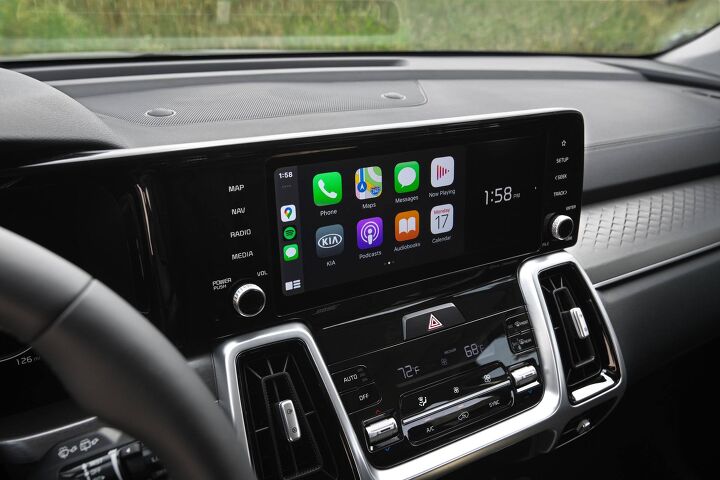


























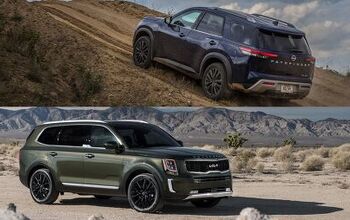


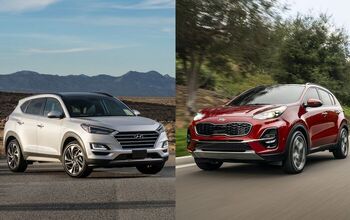
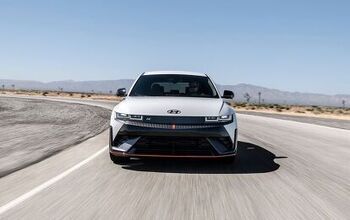




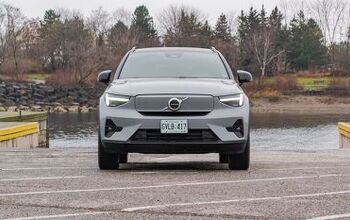


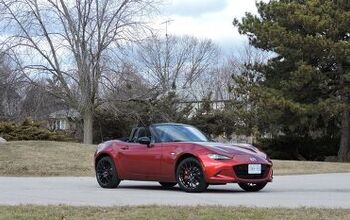
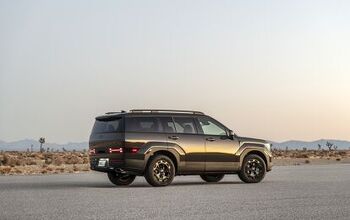
Comments
Join the conversation